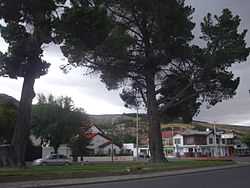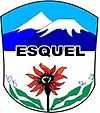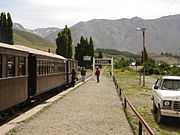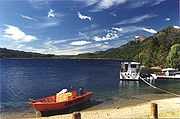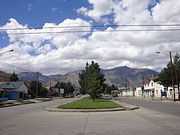Esquel
| Esquel | ||
|---|---|---|
| Town | ||
|
City Centre | ||
| ||
 Esquel Location of Esquel in Argentina | ||
| Coordinates: 42°54′S 71°19′W / 42.900°S 71.317°WCoordinates: 42°54′S 71°19′W / 42.900°S 71.317°W | ||
| Country | Argentina | |
| Province | Chubut | |
| Department | Futaleufú | |
| Founded | February 25, 1906 | |
| Government | ||
| • Mayor | Rafael Williams (Justicialist Party) | |
| Elevation | 563 m (1,847 ft) | |
| Population (2012) | ||
| • Total | 32,234 | |
| Time zone | ART (UTC-3) | |
| CPA base | U9200 | |
| Dialing code | +54 2945 | |
| Climate | Csb | |
| Website | esquel.gov.ar | |
Esquel is a town in the northwest of the province of Chubut, in the Argentine Patagonia. It is located in Futaleufú Department, of which it is the government seat. The town's name derives from one of two Tehuelche words. One meaning "marsh" and the other meaning "land of burrs", which refers to the many thorny plants including the pimpinella and other herbaceous plants whose fruits, when ripe turn into prickly burrs that stick to the animals' skins and wool or people's clothes as a way of propagation.
History
The founding of the town dates back to the arrival of Welsh immigrants in Chubut in 1865. The settlement was created on 25 February 1906, as an extension of the Colonia 16 de Octubre, that also contains the town of Trevelin.
The city, the main town of the area, is located by the Esquel Stream and surrounded by the mountains La Zeta, La Cruz, Cerro 21 and La Hoya. La Hoya is known as a ski resort with good quality snow right through the spring. The Los Alerces National Park is 50 km (31 mi) northwest of the city.
Another important tourist attraction is the narrow-gauge train (with 75 cm between the rails), known as La Trochita locally and in English as The Old Patagonian Express, after the book by Paul Theroux. It is said to be the only narrow-gauge long-distance train in operation and the southernmost railway in the world. The first fifty locomotives were brought from Germany (Henschel & Sohn) in 1922 and were originally modified to use fuel oil and steam. Later twenty-five locomotives were bought from the Baldwin Locomotive Works of Philadelphia. The train remains authentic and in operation thanks to the effort of the team of workers at Talleres Ferroviarios El Maiten, that make a lot of pieces and parts by hand. The trains now run as a tourist excursion between Esquel and the small settlement of Nahuel Pan, located at the foot of the volcano of the same name, with other services all the way to El Maitén. Until 1993, the train ran all the way to the city of Ingeniero Jacobacci in Río Negro, from where trains ran to Viedma and from there to Buenos Aires, forming the General Roca railway.
|
According to the 2001 census [INDEC], the Esquel district had about 28,000 inhabitants, with one of the highest rates of growth in the province, mainly as result of the immigration of people from Buenos Aires, but also from other provinces. It has wide cement streets with sidewalks, and is clean and well maintained. Their hospital is the primary one for the zone and is often a destination for "Medical Tourism" from both foreigners and Porteños (residents of Buenos Aires) alike.
The townspeople have been in a long battle to prevent a gold mine being set up nearby, with concerns that the metal extraction will contaminate the watercourse permanently and irreversibly. Although the mining companies were prohibited from producing mines in the area, there are still monthly street marches against the mines, and the issue never seems to feel fully settled.
In May 2009, Esquel twinned with Aberystwyth in Wales; with representatives of the Welsh town traveling to Argentina to participate in the signing of a charter formalising the link.

Esquel meteorite
In 1951 a farmer found a 755 kilograms (1,664 lb) meteorite, later called Esquel, while digging a hole for a water tank. When cut and polished, the meteorite showed beautiful yellowish olivine (peridot) crystals. The Esquel meteorite is known world wide among collectors and the scientific community.
Climate
Owing to its location on the immediate leeward side of the Andes, Esquel has a Mediterranean climate (Köppen Csb), though it is much more continental than the more classic Mediterranean zones of central Chile, and frosts and even snow are common in the winter months from April to September. Snow falls on average on twenty days each winter but seldom lies on the ground. Summers are generally warm and sunny, though it is still cool at night owing to the town’s relatively high altitude, and cold outbreaks from the south can bring freezing temperatures even during this season.
| Climate data for Esquel (1961–1990, extremes 1901–1990) | |||||||||||||
|---|---|---|---|---|---|---|---|---|---|---|---|---|---|
| Month | Jan | Feb | Mar | Apr | May | Jun | Jul | Aug | Sep | Oct | Nov | Dec | Year |
| Record high °C (°F) | 38.6 (101.5) |
35.2 (95.4) |
32.2 (90) |
27.0 (80.6) |
22.3 (72.1) |
21.2 (70.2) |
20.7 (69.3) |
18.7 (65.7) |
23.5 (74.3) |
29.6 (85.3) |
32.6 (90.7) |
35.0 (95) |
38.6 (101.5) |
| Average high °C (°F) | 21.0 (69.8) |
21.2 (70.2) |
18.9 (66) |
14.8 (58.6) |
10.3 (50.5) |
6.5 (43.7) |
6.3 (43.3) |
8.4 (47.1) |
11.5 (52.7) |
14.5 (58.1) |
17.7 (63.9) |
19.7 (67.5) |
14.2 (57.6) |
| Daily mean °C (°F) | 14.3 (57.7) |
14.3 (57.7) |
12.0 (53.6) |
8.3 (46.9) |
5.1 (41.2) |
2.0 (35.6) |
1.6 (34.9) |
3.1 (37.6) |
5.2 (41.4) |
8.2 (46.8) |
11.2 (52.2) |
13.2 (55.8) |
8.2 (46.8) |
| Average low °C (°F) | 7.6 (45.7) |
6.8 (44.2) |
4.9 (40.8) |
2.2 (36) |
0.2 (32.4) |
−2.5 (27.5) |
−2.9 (26.8) |
−1.6 (29.1) |
−0.6 (30.9) |
1.6 (34.9) |
4.6 (40.3) |
6.4 (43.5) |
2.2 (36) |
| Record low °C (°F) | −5.4 (22.3) |
−4.6 (23.7) |
−7.0 (19.4) |
−11.5 (11.3) |
−12.5 (9.5) |
−21.2 (−6.2) |
−22.8 (−9) |
−18.1 (−0.6) |
−14.8 (5.4) |
−10.3 (13.5) |
−7.0 (19.4) |
−4.5 (23.9) |
−22.8 (−9) |
| Average precipitation mm (inches) | 22.4 (0.882) |
17.9 (0.705) |
20.8 (0.819) |
38.0 (1.496) |
78.9 (3.106) |
85.9 (3.382) |
73.5 (2.894) |
57.7 (2.272) |
37.8 (1.488) |
25.9 (1.02) |
19.5 (0.768) |
25.9 (1.02) |
504.2 (19.85) |
| Avg. precipitation days (≥ 0.1 mm) | 4 | 4 | 5 | 6 | 10 | 10 | 11 | 9 | 7 | 6 | 4 | 5 | 81 |
| Average relative humidity (%) | 49 | 52 | 56 | 63 | 72 | 77 | 77 | 72 | 63 | 56 | 51 | 50 | 62 |
| Source #1: NOAA,[1] Secretaria de Mineria[2] | |||||||||||||
| Source #2: Servicio Meteorológico Nacional (precipitation days)[3] | |||||||||||||
See also
References
- ↑ "Esquel Aero Climate Normals 1961-1990". National Oceanic and Atmospheric Administration. Retrieved March 31, 2015.
- ↑ "Provincia de Chubut - Clima Y Meteorologia: Datos Meteorologicos Y Pluviometicos" (in Spanish). Secretaria de Mineria de la Nacion (Argentina). Retrieved March 31, 2015.
- ↑ "Valores Medios de Temperatura y Precipitación-Chubut: Esquel" (in Spanish). Servicio Meteorológico Nacional. Retrieved March 31, 2015.
External links
| Wikimedia Commons has media related to Esquel. |
- Project-Hiraeth – Documents the stories of the Welsh colony in Patagonia, Argentina through film, text and illustration.
- Municipal information: Municipal Affairs Federal Institute (IFAM), Municipal Affairs Secretariat, Ministry of Interior, Argentina. (Spanish)
- Municipality of Esquel - General, government and tourism information (in English and Spanish).
- Diario information, photographs
- La Trochita
- Tourism information, photographs
